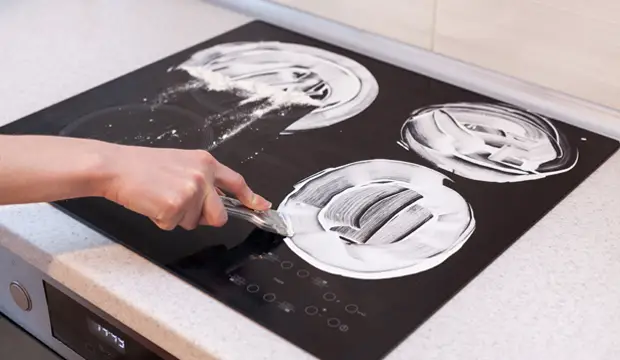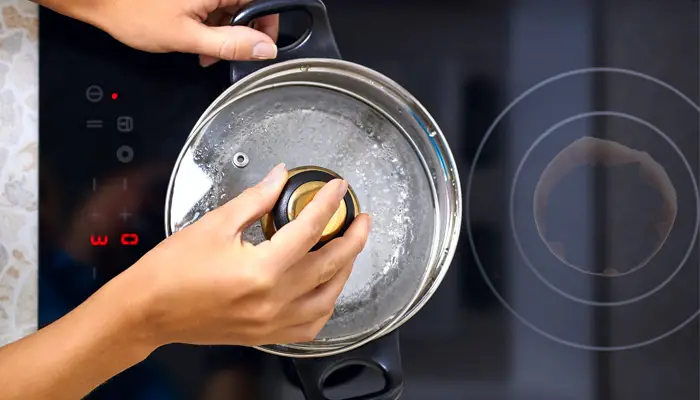Finding a pan mark on an induction hob can absolutely ruin your day. Take it from me, it is a BIG disappointment.
The mirror finish of ceramic glWidgetsass always has that wow factor until something burns on and leaves an ugly mark. It’s even worse if your hob has only recently been installed.
Sometimes the marks might appear as mysterious silvery streaks, or they may have a subtle rainbow sheen. The cause isn’t always obvious, but what can be done to reduce their appearance?
Here are some useful tips about how to deal with infuriating induction hob pan marks and more importantly, how to stop them from happening again.
What’s the Main Cause of Burnt Pan Marks on an Induction Hob?
Can I Clean away Pan Marks on an Induction Hob?

Yes. the good news is that a burnt pan mark on an induction hob can usually be cleaned away. There are specialised products designed for cleaning the glass on a hob, but you might not always have one to hand. Very often, items you have in your kitchen cupboard can help with cleaning.
Some hob guides suggest using bicarbonate of soda, but as an abrasive, it’s best avoided. Salt can also be too harsh for the glass.
Toothpaste is often a suggested remedy, although you must check that it doesn’t contain a whitening abrasive.
One of the best cleaning agents is distilled vinegar, you can apply it neat or dilute it slightly by spraying it onto a damp, natural cotton cloth.
Don’t use paper towels on the hob’s surface as they can cause tiny scratches that won’t ever come off. Gently work the vinegar solution across the stains in a circular motion.
As you clean the glass, you may notice the cloth collects a stain of silvery grey, proof indeed that there’s been metallic contamination. You might need to repeat the application a couple of times to get your hob back to its best.
How to Avoid Leaving Pan Marks on an Induction Hob
Even though you can usually clean away unsightly pan marks on an induction hob, it’s best to avoid them altogether. Here are a few things you can do to avoid getting pan marks on your induction hob.
- Avoid pan boiling dry – Regularly check the water level in your pan. When a pan is being heated without any contents, the metal in the encapsulated base becomes far too hot and transfers to the hob’s glass. Aluminium, a malleable metal, is the most vulnerable. These hob marks often look like silver.
- Use lower heat settings – Inexperience when using an induction hob is often the main problem. It takes time to adjust to how incredibly fast an induction hob heats up compared to a conventional gas or electric hob. With practice, you’ll soon become familiar with how to pace your cooking regarding the induction hob’s speed of temperature change.
- Don’t overfill pans – Allow a safety margin of at least three to five centimetres when topping up pans. Food often expands and bubbles over when heated. I usually find starchy foods such as dried peas, pasta and polenta suddenly erupt out of the pan, especially when on a high setting.
- Wipe up spillages immediately – Leaving hot food on top of the ceramic glass is hazardous. Sugary ingredients are highly adhesive and almost seem to instantly bond with the glass. Wipe up debris quickly to prevent hot food from burning on. If food does dry hard, pour a little water on top of it and leave it to soak for at least thirty minutes. It should then lift off without any difficulty.
- Invest in silicone mats – These flexible induction hob protectors are effective at keeping the ceramic glass free of marks. Simply cover the hob with one and it should catch any spillages. It can also limit metal contamination caused by an overheated pan. However, always check the manufacturer’s instructions before use as protectors often have a maximum heat limit. Go beyond that and you might have silicone rubber leaving an imprint or pan mark on your induction hob.
Do Pan Marks on an Induction Hob Fade with Time?
Yes, stubborn induction hob pan marks usually fade over time. It might take longer if you regularly use very high temperatures or if you have a pan in place for a long time.
Do Burnt Pan Marks Affect the Performance of an Induction Hob?
Yes. A pan mark on an induction hob is a sign of residue building up. Forgetting to clean the ceramic glass after every cooking session contributes to these blemishes.
They aren’t noticeable at first, but their presence can interfere with the hob’s performance.
Although electromagnetic radiation can penetrate glass, silicone rubber and metal pans, grease has an uncanny way of reflecting it back inside the hob.
Summing up
Finding a burnt pan mark on an induction hob is indeed a great disappointment. It spoils the aesthetic appearance of your beautiful induction hob and might even affect its reliability. However, it is usually possible to remove the majority of stains.
You can help prevent pan marks on your induction hob by keeping an eye on the heat and regular cleaning and ensuring debris isn’t stuck to the base of your pan.
Ultimately, your induction hob was installed to be used and not just admired. Why not take a balanced approach? Consider investing in an inexpensive induction hob protector mat.
